
Stop overpaying - start transferring money with Ogvio. Sign up, invite friends & grab Rewards now! 🎁
If you’re dabbling in cryptocurrency, you may not be a stranger to the Binance exchange and its built-in Binance wallet. However, recently, a new kid has introduced itself to the block, and it will be the main star of this Binance Web3 Wallet review.
This game-changing wallet is rather unique as it deals with all things decentralized. Imagine a virtual pocket to store your NFTs, meme coins, and treasured assets. But is the Binance Web3 Wallet safe? I can confidently say yes, but we’ll look into this later.
Nevertheless, before you explore the world of DeFi (decentralized finance), gear yourself up—let’s take a closer look at the pros and cons of this brand-new Web3 wallet from Binance.
Verdict at a Glance: The Binance Web3 Wallet is the ultimate companion for your wondrous adventure into the world of DeFi. It is a seedless semi-self-custody wallet with MPC-powered security, convenience in mind, and integrations with tons of dApps and networks. The only lackluster is the lack of the Binance Web3 Wallet extension, which hopefully will be available in the future.
Pros
- Semi-custodial meets next-gen MPC
- Incredibly easy-to-use
- Connectivity to various dApps
- Access to token swapping through Bridge 2.0
- Potential yields through staking
Cons
- No browser extension
Table of Contents
- 1. What is the Binance Web3 Wallet?
- 1.1. Trust Wallet VS Binance Web3 Wallet
- 2. Binance Web3 Wallet Review: PROS
- 2.1. A Semi-Custodial System Paired with Multi-Party Computing (MPC)
- 2.2. Designed With Convenience in Mind
- 2.3. Blockchains and dApps, Harmonized
- 2.4. The Enthralling World of Bridge 2.0 and Token Swapping
- 2.5. Opportunities to Nurture Your Portfolio
- 3. Binance Web3 Wallet Review: CONS
- 3.1. Lack of a Browser Extension
- 4. Binance Web3 Wallet Fees
- 5. How to Set Up the Binance Web3 Wallet?
- 6. Conclusion
What is the Binance Web3 Wallet?
In answering what is the Binance Web3 wallet, you’ll often see that it is described as self-custodial. Launched in November 2023, this software wallet is actually semi-custodial, and I will explain it further a bit later in this Binance Web3 Wallet review.
Before that, there is actually another wallet in Binance offerings we should briefly discuss: the Binance wallet. Just like the Binance Web3 Wallet, both of them are built right into the crypto exchange. However, there’s a clear discrepancy.

The Binance wallet is what you’ll use by default when you’re trading or earning digital assets on the platform. However, the Binance Web3 Wallet puts more emphasis on mobile experience and instant connectivity to dApps. If you’d like to enter the NFT marketplace, swap, or stake your tokens across multiple blockchains, the Binance Web3 Wallet app is your option.
Then, there’s the Trust Wallet. Let’s see how this compares with the Binance Web3 Wallet, too.
Trust Wallet VS Binance Web3 Wallet
The Trust wallet was independently developed by one individual named Victor Radchenko in 2017. A year later, it amassed quite a user base, and Binance acquired it. Just like the Binance Web3 Wallet, Trust also focuses on dApp connectivity.
Well, this might be confusing, but let’s clear up the debate between the Binance Web3 Wallet VS Trust wallet. First, the Trust wallet itself is not adjacent to the Binance exchange and even has its own mobile app and browser extension.
Another clear difference between the Binance Web3 Wallet VS Trust wallet is that while the former prides itself on ease of use, the latter is more sophisticated. The Trust wallet, in particular, offers unrestricted access to the wide realm of dApps.
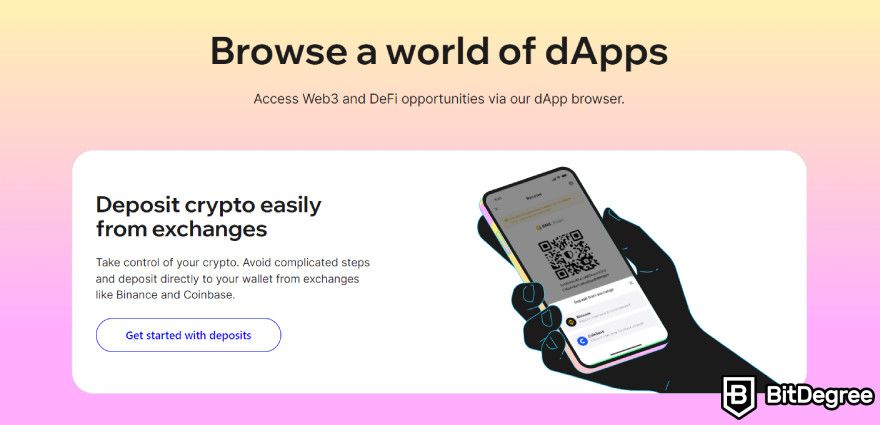
Further, if you search for user Binance Web3 Wallet VS Trust wallet reviews, you’ll come across a discussion on how one is self-custodial while the other is non-custodial. Essentially, these terms mean the same.
Though, the Binance Web3 Wallet is actually semi-custodial. This means users are not 100% responsible for protecting their private keys, as Binance sort of intervenes. For some people, this might give a sense of reassurance, especially if you’re forgetful of your private keys. We’ll talk about this later.
Knowing all these differences in mind, hopefully, the answer to what is the Binance Web3 Wallet comes into a clearer picture. It is noteworthy that while comparing the Trust wallet VS Binance Web3 Wallet, there are still some ties between the two.
![]()
The engineering team behind Trust wallet is involved in the making of the Web3 wallet from Binance, adopting the same Wallet as a Service (WaaS) technology. While Trust provides the underlying software, Binance, as an entity, has autonomous control over its Web3 wallet’s operations, features, and services.
After reading up on what is the Binance Web3 Wallet, now it’s time to look at its features as I weigh the pros and cons so you can make a decision.
Binance Web3 Wallet Review: PROS
What is the Binance Web3 Wallet, and what are its pros? From my research and hands-on experience on the platform, I find that its strongest suits lie in its security, ease of use, and portfolio diversification. Let’s further explore these aspects in this Binance Web3 Wallet review.
A Semi-Custodial System Paired with Multi-Party Computing (MPC)
As you’ve probably read in user Binance Web3 Wallet reviews, security tends to be the first and, at times, the most important factor to evaluate. After all, nobody wants their hard-earned assets hijacked by a hoodie-wearing hacker with a sinister grin.
So, is the Binance Web3 Wallet safe? Now, to answer this question you first need to understand that this is a type of hot wallet that is semi-custodial, even if Binance claims it to be self-custodial in some places.
With a self-custodial wallet, you are fully responsible for your private keys, the encryption method to unlock your wallet. On the other hand, with a semi-custodial wallet, Binance also helps you in keeping those keys.
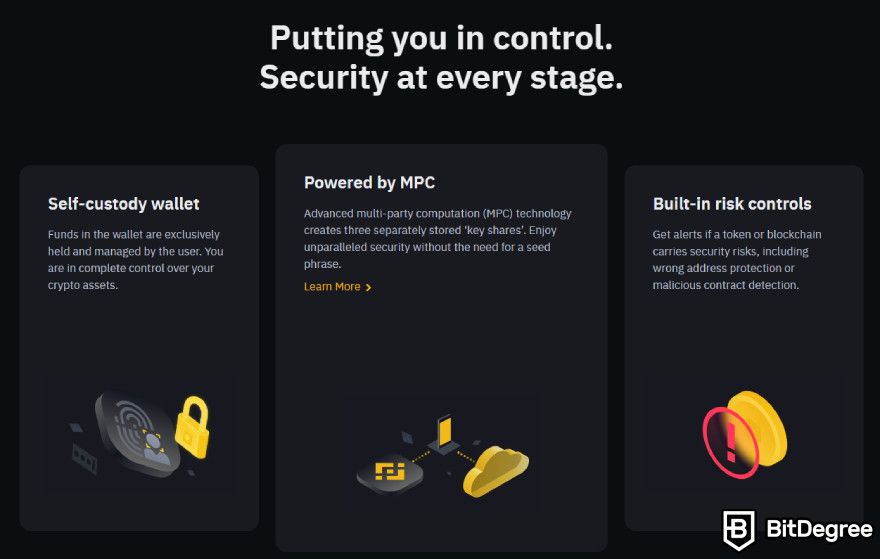
Human errors are inevitable. What if your private keys get lost? Most of the time, a self-custody wallet does not have a recovery service. Tragically, if that worst scenario happens, you can no longer access your funds.
The Binance Web3 wallet, uniquely, has a fail-safe measure. If you forget your private keys, don’t panic; Binance helps you out with recovery passwords. So, you kind of get the best of both worlds: personal control of your access with extra assistance when needed.
This semi-custody wallet is also known for its multi-party computation (MPC). Any MPC protocol is designated to be fair and robust, ensuring that every execution will be carried out when the evaluation is deemed “fair” by multiple contributing parties[1].
In the MPC system of the Web3 wallet from Binance, the platform uses three key shares instead of a single seed phrase, which is more prone to getting lost. These key shares are stored in three separate locations, guaranteeing no single point of failure:
- Share 1 is secured by Binance.
- Share 2 is stored on your device.
- Share 3 is encrypted with a recovery password.
In the best interest of protecting your assets, backing up your third share to your personal cloud storage, such as iCloud and Google Drive, is mandatory for using the wallet. Simultaneously, your wallet requires at least two key shares to be accessed.
The Binance Web3 Wallet also puts user protection as its priority with the risk control mechanism. Before you engage with a blockchain or a token fueled with security risks, or if a suspicious account tries to hack your wallet address, the Web3 wallet from Binance will issue an alert.
Most of all, your funds will be “SAFU”. Think of it as insurance provided by Binance through its $1 billion-valued emergency fund, also known as The Secure Asset Fund for Users (SAFU).
Going back to the question, is the Binance Web3 Wallet safe? Being a self-custodial solution that champions the highly secure MPC system, the answer is a resounding yes.
Designed With Convenience in Mind
Binance repeatedly peddles how this Web3 wallet is user-centric, but is that truly the case? Let’s find out in this Binance Web3 Wallet review.
Web3 is a world full of potential, but challenges are blocking the way for its widespread adoption. That said, as the internet continues to evolve, the enablement of Web3 will expand across the digital ecosystem[2]. With the release of the Web3 wallet, Binance is taking part in this revolution—providing the lowest entry into this futuristic universe.

For one, Binance makes it easy to use the wallet. Mind that there’s no Binance Web3 Wallet app, so to open your funds, you need to do it via the Binance app. Whether you’ve interacted with Binance or not, you can breathe a sigh of relief as the platform is seamless to navigate. Its mobile app is also free to download on Apple or Google Play.
I’ll guide you through the step-by-step to create a Binance Web3 Wallet app account a bit later, but I can assure you that it’s a quick process that will only take a couple of taps (and seconds!). Plus, you don’t need to go through the hassle of generating a master key or a seed phrase.
Once your Web3 wallet is up and ready, you’ll find the dashboard incredibly straightforward to navigate with its sleek and clutter-less design. You’ll see your total funds at a glance, with buttons to send, receive, or transfer assets and a variety of functionalities like wallet backups made simple by the user-friendly setup wizard.

Getting into the fun stuff—accessing dApps. If you use blockchains or dApps, you’re probably familiar with how tedious the ordeal can be: connecting your wallet, opening the dApp, tracking the transactions, etc. However, with the Binance Web3 Wallet’s “Earn” section, these steps are conveniently streamlined.
No longer do you have to log into a dApp only to view the lending rates of specific tokens—the Binance Web3 Wallet app lets you do this directly, with no intermediary needed.
Blockchains and dApps, Harmonized
Moving across Web3 is definitely a surf via the Binance Web3 Wallet. Whether you’re looking to swap some tokens using the Binance Web3 Wallet on Solana or dApps like Venus, let’s see how far you can travel in this multi-chain ecosystem.
For starters, this Web3 wallet supports 70+ networks, including the classics like its very own BNB Chain, Bitcoin, and Ethereum. Now, 70 may not sound much at first. Remember, Ethereum alone hosts thousands of tokens under its ETH-20 smart contract, so you can add more assortment to your coin collections.
More importantly, if you’re talking about the Binance Web3 Wallet, Solana is one blockchain you can’t forget. The listing of the meme coin BOME, built on the said blockchain, created some buzz between the Binance Web3 Wallet and Solana communities.
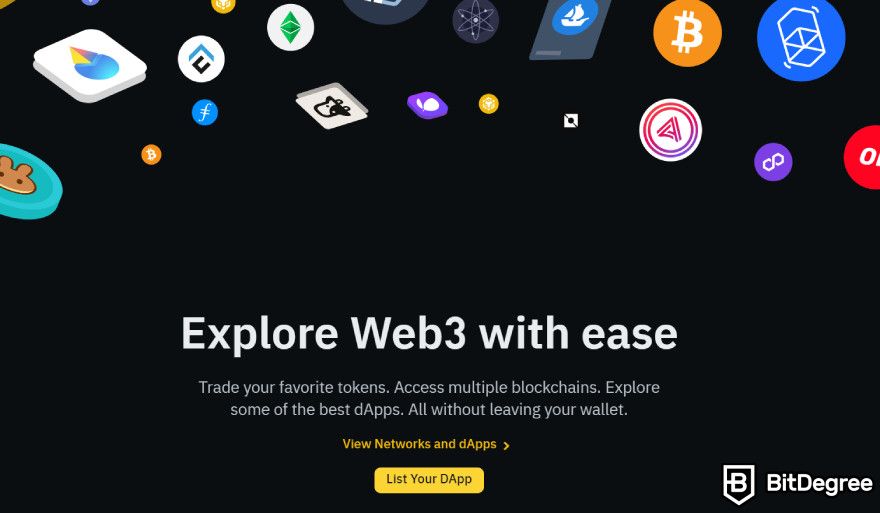
If you’re here, though, chances are you’re searching for digital assets beyond Bitcoin or the popular options in the Binance Web3 Wallet, like Solana or Ethereum. After all, what is Web3 without altcoins? If you’re a fan of Dogecoin or have been eyeing Litecoin, you can also get them through Binance’s Web3 wallet.
What if you’re into more niche yet trendy coins or tokens? You’ll be glad to discover in this Binance Web3 Wallet review that the platform supports Stride, Stargaze, and Degen networks—among others. Considering that Binance’s Web3 wallet was launched pretty recently (as of writing), this is a more-than-good start.
Going forward, we can expect more coming from this Web3 wallet. I may or may not be guessing your thoughts—more networks, less accountability. Well, one thing you should know is that Binance takes its network curation process very seriously.
So, probably, not all networks, coins, and tokens will be supported by this Web3 wallet—well, theoretically, this is impossible to pull off. As a user, though, you can have peace of mind knowing you’re going into an exchange that only lists trusted products, so to speak.
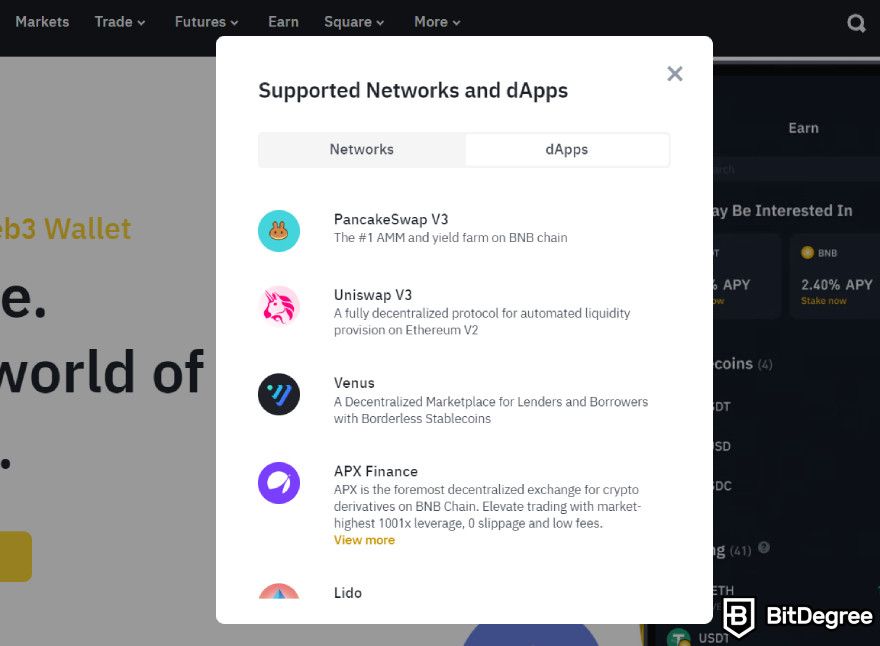
Now, going into dApps, the Binance Web3 Wallet is notably huge in this department. From decentralized exchanges (DEXs) like Uniswap to PancakeSwap, using this Web3 wallet, you’ll open the gateway to 100+ dApps!
You can cruise through various NFT marketplaces to fish for NFT collectibles or game it all out for potential token rewards on blockchain-powered games. These are a few examples of the activities you can do with the Binance Web3 Wallet—promising an exciting adventure for traders eager to diversify their portfolio.
What’s more to see in this Binance Web3 Wallet review? Some people prefer to hold, while others prefer to do more. Let’s see what you can do with your digital assets.
The Enthralling World of Bridge 2.0 and Token Swapping
Deep into this Binance Web3 Wallet review, you’re probably wondering how you can go the extra mile being a Web3 explorer. Remember when I told you that Binance Web3 is a multi-chain wallet? This means you can navigate multiple blockchains at once while finding the best prices for your token swaps!
A central element to this is the Binance Bridge, your VIP pass to dive deeper into blockchains, DeFi, crypto games, the metaverse, and more. As of writing, Binance has released Bridge 2.0, bridging you to tokens that are not listed on the exchange.
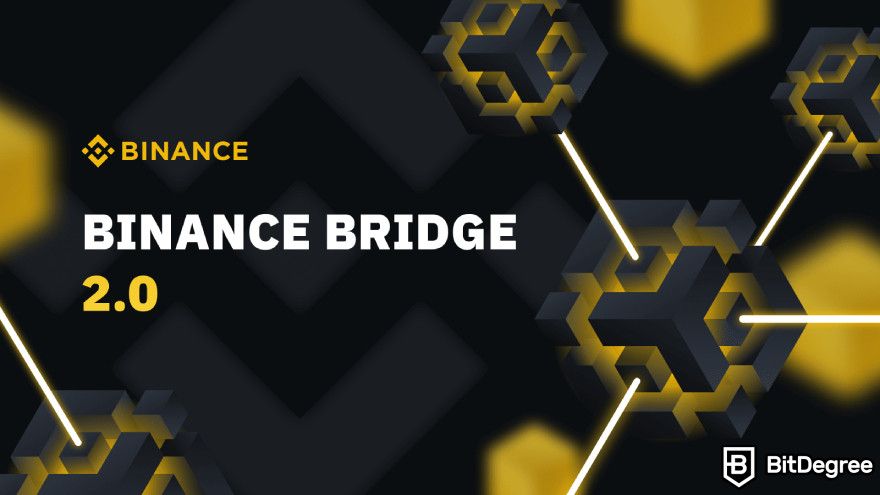
Thanks to the Binance Web3 Wallet, you don’t need to use third-party services to take a journey outside the decentralized BNB Chain ecosystem. If you buy the listed tokens, those will go into the Funding or Spot wallet.
Unlisted bridge tokens, on the other hand, will go into your Binance Web3 Wallet. As I’ve explained in this Binance Web3 Wallet review earlier, storing your tokens will come with an extra layer of protection, thanks to the way private keys are handled.
What’s more special about this Web3 wallet from Binance is how it combines the power of Bridge 2.0 and 100+ supported DEXs. This gives you deep liquidity and low slippage to trade thousands of token selections. The possibilities are endless!
Let’s start with an illustration—say you’d like to wrap your ERC-20 tokens to receive BEP-20 tokens, then stake your ETH or other DeFi assets. For instance, BEP-20 tokens are pegged on a 1:1 basis to the original ERC-20 token, and you can redeem it to its original value anytime.
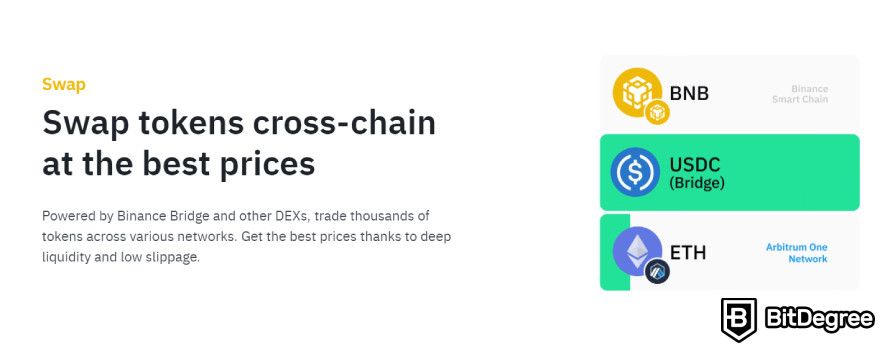
Thanks to the advanced technology of the BNB Smart Chain, boosted by Bridge 2.0 and DEXs, you no longer need to be concerned about duplicate swaps or jacked-up fees. As a result, the transaction time is much shorter, too; the standard for the BNB Smart Chain is 3s.
Keep in mind that when navigating different networks, you’ll need to figure out the tokens and blockchain you want to use. Gas fees will apply, varying based on the selected blockchain. For instance, Arbitrum requires ETH for gas, while Polygon will take POL.
Determining your next step is similar to doing trades in general. If this is your first time, make sure to proceed with caution. Even if you’re a seasoned pro, knowing how to protect yourself is the most priceless asset of all.
Opportunities to Nurture Your Portfolio
Still looking for ways to diversify your portfolio? Aside from in-wallet token swapping, let’s take a look at the token staking functionality in this Binance Web3 Wallet review.
If you’re new to staking, it’s the process of locking up your digital assets to serve as transaction validators within a Proof-of-Stake (PoS) blockchain. As a result, you’re not only strengthening the security of the entire network but also reaping potential rewards along the way.
With the Web3 wallet from Binance, you can do a bit more than staking tokens on supported networks like Ethereum. Remember when I told you about Bridge 2.0 in the previous chapter of this Binance Web3 Wallet review? This system is your bridge to the exciting world of Web3, where you can explore various staking options on dApps.
For example, with Binance Web3, you can perform in-wallet staking through Uniswap—one of the largest DEXs for Ethereum. By joining Uniswap’s liquidity pool, you can stake your ETH directly from your ERC-20 compatible Binance Web3 Wallet. Plus, Uniswap has a one-of-a-kind protocol that will automate the liquidity process for your convenience.
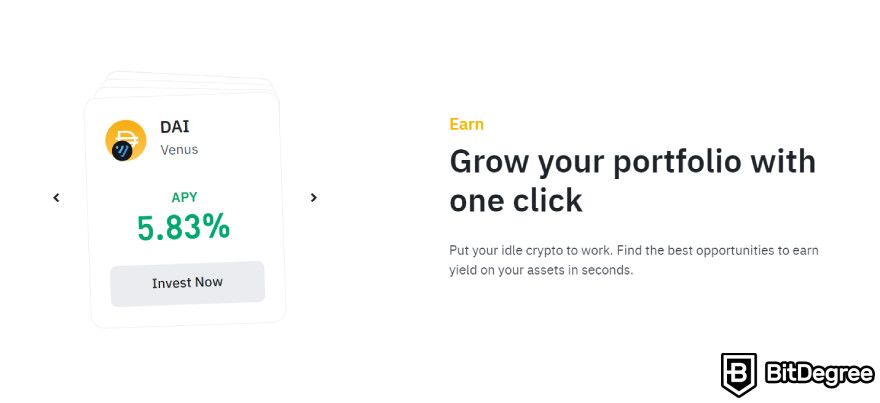
Talking about Binance, though, a notable dApp in this space is the PancakeSwap V3. Connected to the BNB Chain, you can take part in a range of staking programs: weekly yield, revenue share, farm yield boosting, and more.
Perhaps a question you’re waiting for the answer in this Binance Web3 Wallet review: How high is the yield you can earn from putting your idle assets to work? To make complex things simple, it depends. Here’s the Annual Percentage Yield (APY) you can earn from staking the following coins or tokens on Venus, one of the dApps that can be accessed through the wallet:
- DAI, an APY of up to 5.9%
- ETH, an APY of up to 0.57%
- BNB, an APY of up to 0.76%
- USDT, an APY of up to 6.23%
- USDC, an APY of up to 6.32%
Keep in mind that these numbers are accurate as of writing, but as with everything in the sphere of crypto, the market can change. Staking may sound tempting, but please take notes of the pros and cons before getting started.
There’s some good news: Binance takes responsibility for all slashing risks. Slashing refers to the penalty given to stakers involved in improper actions that compromise the network’s operation, like double-signing or censorship. If such an incident occurs, Binance will return the full amount of the digital assets you initially staked, even if they are subject to slashing.
However, Binance does not protect all staking products, so watch out before you take a step!

Did you know?
All Crypto wallets may look similar to you but they're NOT all the same!
Binance Web3 Wallet Review: CONS
After looking into the pros, just like any other wallet, Binance Web3 is not devoid of any cons. Nothing too critical to note, but still important to address in this Binance Web3 Wallet review.
Lack of a Browser Extension
A point noted as a con in several user Binance Web3 Wallet reviews is that, as of writing, only the mobile app version of the wallet is available.
However, even if there’s no Binance Web3 Wallet extension, it is not an entirely deal-breaker. Generally, crypto wallets are designed to be convenient, and therefore, mobile access is preferred. However, this doesn’t take away the fact that some users might prefer a fuller window view of their trading activities, which is more feasible through a desktop interface.
The Binance Web3 Wallet is actually pretty new. Knowing Binance, the platform is rarely out of innovations and is constantly at the forefront of setting industry benchmarks. So, let’s see what the future holds.
As you wait, the mobile app for the Binance Web3 Wallet is already extensive enough, offering all the necessary trading features to keep you focused.
Binance Web3 Wallet Fees
Now, before we get to the more practical part of my Binance Web3 Wallet review, let's talk about fees.
When dealing with software or hot wallets in general, there is no setup cost involved. It’s completely free to create your wallet, and once that’s done, you can go ahead and use it. This is one of the main reasons why sometimes users prefer hot compared to cold wallets—it’s just so simple to use. Most importantly, if you’re a beginner, you wouldn’t need to worry—no investment is required for your first trial.
If you carry out trading activities, though, the same as other crypto wallets or exchanges, you’ll need to prepare a minimum deposit and pay for the gas fees. These are the small amounts you pay to compensate the validators and miners for the computational resources required to process transactions on a blockchain.
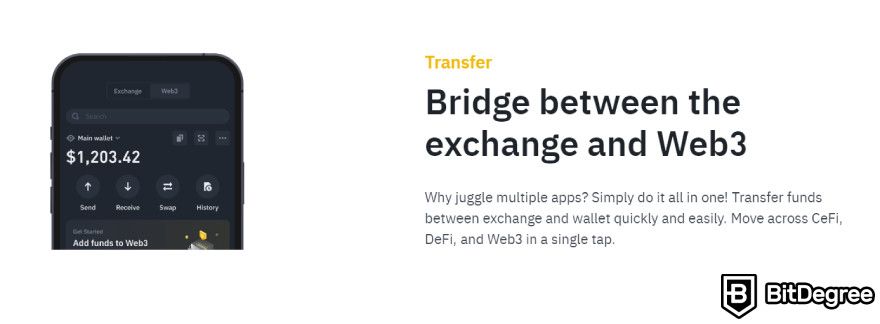
As for the specific gas fees you need to pay, it completely depends on network traffic, validators, and demand. Expect some fluctuations; any movement in the market can affect the total fees you pay. If you’re confused, there are plenty of gas fee calculators that will come in handy in giving estimations, although they may not be 100% accurate.
Remember that these fees are important for the scalability of the exchange itself, which will benefit you in some ways. Every percentage of your transaction goes into maintaining the platform for performance stability, future innovations, feature improvements, and more.
Just make sure to be very careful when carrying out transactions. Refunds are not possible if you’re sending your assets to the wrong address. Per the standard of any crypto wallet or exchange, gas fees will still be incurred if an executed transaction fails.
How to Set Up the Binance Web3 Wallet?
Before officially using the Binance Web3 Wallet, you’ll need to have the Binance mobile app. Download the app first if you don’t have it yet, follow the steps for signing up, and most importantly, complete your KYC process. Believe me, it’ll go a long way in protecting your account.
Now, let’s get into the actual steps to set up a Binance Web3 Wallet:
Step 1: Log into your Binance mobile app and search for the Binance Web3 Wallet under "Services". Once found, click on "Create Wallet".
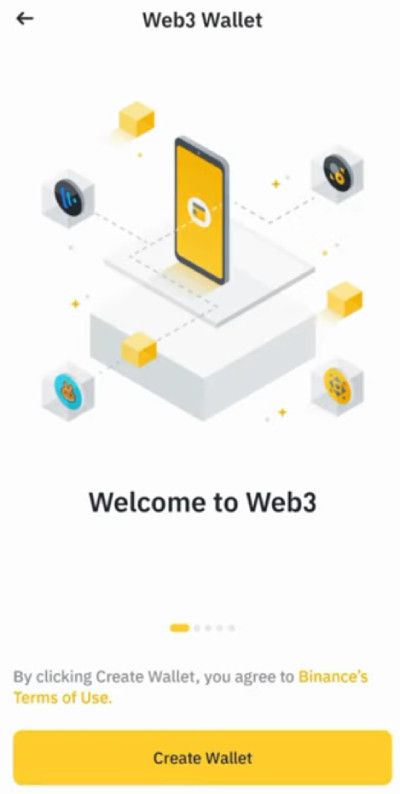
Step 2: Wait until the wallet creation process is complete. It will usually take 4 to 5 seconds.
Step 3: Complete both security verification requirements via the authenticator app (like Google Authenticator) and email.
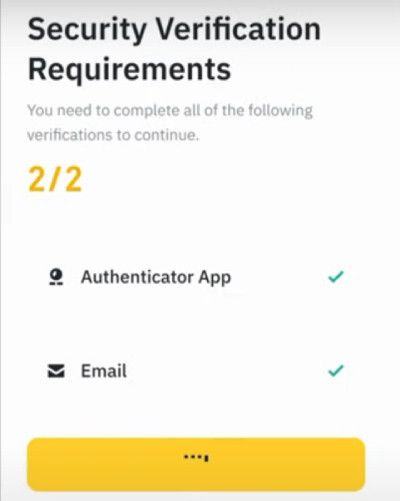
Step 4: Activate your wallet backup. This step is important for an extra layer of protection.
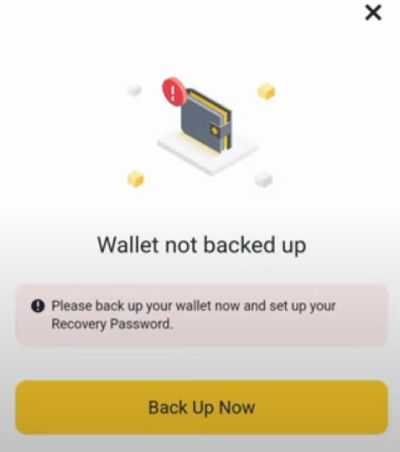
And that’s it! Simple, right? No seed phrase is needed, either. Once your wallet is set up, you’re free to go with your adventure across the Web3 world!

- User-friendly design
- Robust security
- Long battery life

- Dual auditable Secure Element chips
- Quantum-resistant protection
- Water and dust resistant

- Transaction Check feature
- Direct dApps connection
- Great middle-ground price
Conclusion
Closing this Binance Web3 Wallet review, is it worth it? Based on everything we’ve discussed, this wallet definitely deserves an exploration. While it’s still brand new, that just means you have the exciting opportunity to grow with the platform as you explore its features.
Binance Web3 is a keyless and self-custodial wallet with advanced security systems powered by the MPC protocol. Beyond that, it’s seamless to use—the ideal “pocket wallet” to accompany you across 70+ networks and 100+ dApps, complete with in-wallet token swapping and staking capabilities.
Although this Web3 wallet does seem to check all the boxes, one aspect goes unchecked—the absence of the Binance Web3 Wallet extension. Fingers crossed that this will be available in the near future!
The content published on this website is not aimed to give any kind of financial, investment, trading, or any other form of advice. BitDegree.org does not endorse or suggest you to buy, sell or hold any kind of cryptocurrency. Before making financial investment decisions, do consult your financial advisor.
Scientific References
1. A. Kiayias, H.S. Zhou, V. Zikas: ‘Fair and Robust Multi-party Computation Using a Global Transaction Ledger’;
2. D. Sheridan, et al.: ‘Web3 Challenges and Opportunities for the Market’.


